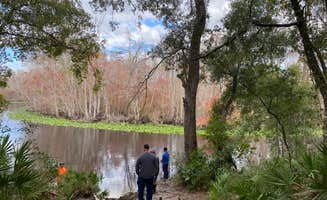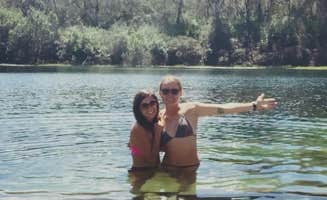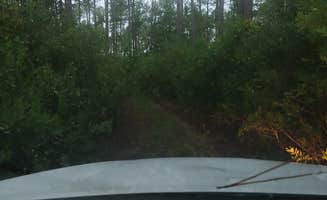Primitive camping near Crescent City, Florida centers around Ocala National Forest locations where campers must be entirely self-sufficient. Forest Service Road 65 provides the primary access corridor to most dispersed sites, with sandy soil conditions that can challenge low-clearance vehicles year-round. Sites range from riverside locations to inland forest clearings, with elevation changes rarely exceeding 30 feet due to Florida's naturally flat topography.
What to do
Fishing opportunities: Multiple sites offer direct river access for anglers. At St. Johns River Dispersed Spot, "Right next to the river and the trees open up so you get a great view of the stars," notes camper Mike D. The Ocklawaha and St. Johns Rivers both support bass, catfish and bream fishing.
Swimming in natural waterways: Natural swimming spots provide relief during hot months. Freak Creek Dispersed Camping offers "a nice creek area where you can swim and or fish if you have the right equipment to get back there," according to Hilary G. Water clarity varies seasonally, with best conditions typically from November through April.
Night sky viewing: Limited light pollution makes stargazing exceptional at several sites. Mike D. reports that at St. Johns River Dispersed Spot, "the trees open up so you get a great view of the stars." Winter months provide clearest viewing conditions when humidity levels drop.
What campers like
Isolation from crowds: The challenging access roads create natural barriers that limit visitor numbers. Adamm A. notes that Freak Creek Dispersed Camping is "super secluded and quiet. Depending when you stay there's at times people who show up to party and then leave."
Wildlife observation: The forest supports diverse wildlife viewing opportunities. Hilary G. mentions at Freak Creek Dispersed Camping that she "talked to another person that use to go out there and said she has seen a panther." Local wildlife includes deer, turkey, and various bird species.
Water access points: Several campsites provide direct access to rivers and waterways. David P. describes Davenport Landing as a "Big open spot" that's "great" for tent campers and those with vans, though notes the "last 100 yards driving back in were very bumpy."
What you should know
Vehicle requirements: Most sites demand appropriate vehicles and recovery equipment. For Freak Creek Dispersed Camping, Hilary G. warns "The main road in has huge deep ruts, the other road has a water crossing that was over my bumper on my lifted Mojave... If you don't have 4wd and recovery gear I wouldn't risk it."
Site conditions vary seasonally: Summer brings insects and potential flooding, while winter offers milder temperatures and drier conditions. Regarding Trout Lake Primitive Sites, Entropical Breeze notes it has a "Main road entry is packed dirt; smaller access road to sites is two-track about 1/4 mile through woods — very narrow tree clearance. 4WD recommended."
Communication limitations: Cellular coverage is minimal to nonexistent. Entropical Breeze mentions Trout Lake Primitive Sites has "Poor cell service even with booster. Plan on returning after antenna upgrade." Forest roads often lack signage, making physical maps essential.
Tips for camping with families
Safety considerations: Wildlife awareness and careful site selection minimize risks. Frank E. describes Davenport Landing as "Generally quiet primitive camping with water access" but notes it "gets some traffic visiting historic site," which can impact privacy during daytime hours.
Best time windows: Late fall through early spring offers the most comfortable camping conditions with fewer insects. Weekdays typically see lower visitor numbers at all sites.
Basic amenities planning: No sites provide drinking water, toilets, or trash facilities. At Blue Sink, Destiny R. calls it the "Most beautiful place to stumble upon" but warns "You may need ATV or creative backpacking to get there now. The Forestry Service recently chopped down trees and covered the easy access roads."
Tips from RVers
Vehicle clearance requirements: Narrow forest roads create challenges for wider vehicles. Joe P. says about Trout Lake Primitive Sites: "Very narrow trails but really easy access, you will leave with some new pinstripes."
Site access limitations: Most sites accommodate smaller rigs only, with backing challenges common. Entropical Breeze notes at Trout Lake Primitive Sites they "Just barely scraped a FWD Promaster through the trees, into a pullout just before sand started."
Surface conditions: Sandy and uneven terrain requires careful site selection. Several campgrounds feature loose sand that can trap vehicles after rain or during dry conditions when sand becomes less compacted.




